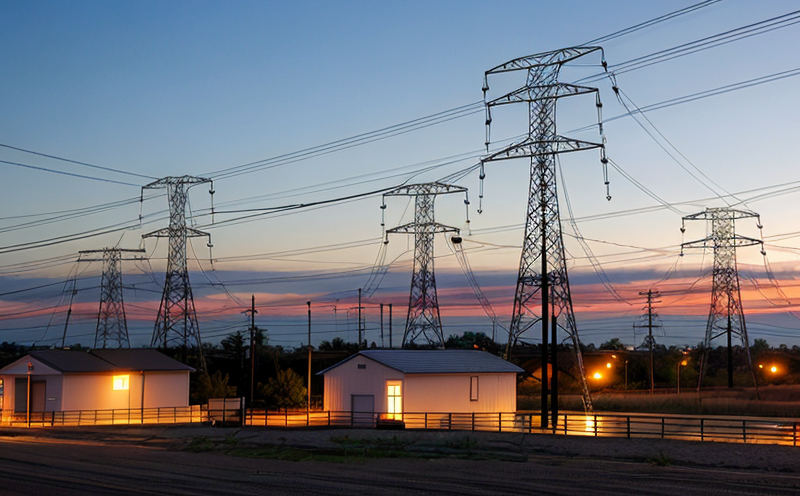IEEE 693 Seismic Reliability Testing of Grid Equipment
The IEEE Standard 693-2015, "Recommended Practice for Design and Performance of Earthquake Resistant Power Distribution Systems," provides guidelines to ensure the reliability and resilience of electrical grid equipment in seismic regions. This service focuses on testing these systems against seismic forces using rigorous methods prescribed by the standard.
The IEEE 693 seismic reliability test is a critical component of ensuring that power distribution networks are designed with consideration for potential earthquake events. The test evaluates not only the structural integrity but also the functional performance of grid equipment under simulated seismic conditions. This service involves comprehensive testing procedures to assess how well these systems can withstand and recover from the stresses imposed by earthquakes.
The process begins with a thorough examination of the equipment to be tested, ensuring it meets all specified design parameters outlined in IEEE 693. Specimen preparation is critical; this includes securing components into place within the test rigging system that simulates real-world conditions during an earthquake. Once prepared, the specimen undergoes dynamic loading tests using specialized shakers capable of generating controlled levels of ground motion.
During testing, engineers monitor various performance metrics such as mechanical deformation, electrical continuity, and thermal behavior to determine whether or not the equipment can continue functioning properly after exposure to seismic activity. After completing each test cycle, data is collected and analyzed to compare against baseline measurements taken prior to loading. This allows us to quantify any changes in performance that may indicate potential weaknesses within the design.
Our team uses advanced instrumentation such as accelerometers, strain gauges, thermocouples, and other sensors to gather precise information throughout every phase of testing. These readings help identify areas where improvements could be made to enhance resilience further while maintaining operational efficiency during normal service operations.
The results from these tests are then compiled into detailed reports that provide insights into the overall condition of the equipment as well as recommendations for future modifications if necessary. By adhering strictly to IEEE 693 guidelines, we ensure compliance with industry best practices and international standards when performing this important assessment.
| Test Parameters | Specimen Preparation | Instrumentation Used | Data Collected |
|---|---|---|---|
| Seismic loading levels | Securing components into place within test rigging | Accelerometers, strain gauges, thermocouples | Mechanical deformation, electrical continuity, thermal behavior |
Why It Matters
The integrity of our power distribution systems is vital to maintaining critical infrastructure during and after natural disasters like earthquakes. By conducting IEEE 693 seismic reliability tests, we can identify potential vulnerabilities early on before they have a chance to cause widespread disruption or failure.
This proactive approach helps protect both personnel safety as well as minimize downtime for essential services such as hospitals, emergency response facilities, and communication networks. Additionally, compliance with this standard demonstrates commitment towards sustainability goals by ensuring long-term reliability without compromising operational effectiveness.
Through rigorous evaluation of grid equipment under simulated seismic events, we contribute significantly to improving public confidence in the resilience of our energy infrastructure against natural hazards. This testing also supports efforts toward achieving greater sustainability through more robust and efficient design practices that account for environmental factors like climate change impacts on seismic activity patterns over time.
Industry Applications
The IEEE 693 seismic reliability test finds application across various sectors including utilities, municipalities, and private companies involved in power generation, transmission, and distribution. Here are some specific examples:
- Utility companies looking to comply with local building codes requiring earthquake-resistant design standards.
- Municipal governments seeking to ensure their critical infrastructure remains operational during emergencies.
- Private firms interested in enhancing the durability of their products for use in high-risk seismic zones.
In each case, adherence to IEEE 693 ensures that equipment is not only safe but also capable of withstanding extreme conditions without compromising performance or reliability. This contributes directly to minimizing risks associated with natural disasters while promoting sustainable practices within the industry.
Environmental and Sustainability Contributions
The IEEE 693 seismic reliability test plays a crucial role in supporting broader environmental sustainability objectives by helping to reduce carbon footprints associated with power outages caused by earthquakes. Here are several ways this testing contributes positively:
- Minimizing downtime for essential services reduces the need for backup generators, which often rely on fossil fuels.
- Ensuring uninterrupted service helps prevent waste from unnecessary production and consumption during periods of crisis.
- Promoting resilient design encourages manufacturers to adopt more sustainable materials and manufacturing processes.
By investing in IEEE 693 seismic reliability testing, organizations demonstrate their commitment to responsible environmental stewardship while simultaneously enhancing public safety and preparedness for future challenges posed by climate change-induced natural disasters.





